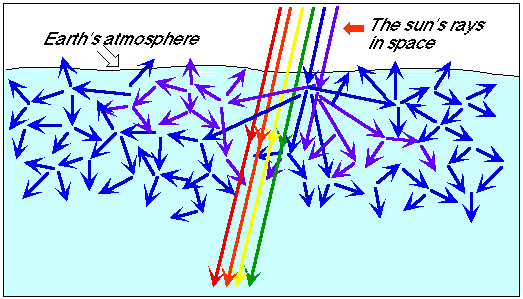
Do you remember asking this question when you were younger? Did you get an answer? If not, why did you stop searching for it? I find this to be a wonderful question with a fascinating explanation.
I remember one of the possible explanations I heard when I was younger was that the blue in the sky is the reflection of the blue ocean. But if you think about it, this could not be farther from the truth. We know from experience, that water is transparent. Look at any ordinary Poland Spring bottle and you will see that this is true. So in fact, the blue in the sky is not a reflection of the blue ocean, it is actually the other way around! The blue in the ocean is the reflection of light from the blue sky.
The sky is blue due to a phenomenon known as Rayleigh Scattering. It works as follows. Light is a form of electromagnetic radiation, and all EM radiation is composed of something called an electric field. When you put matter into an electric field, the protons and electrons become partially separated. They form one side that is slightly more positive and another side that is slightly negative. Something with a positive and negative end is called a “dipole” (i.e. two poles). If you have an electric field that flips back and forth constantly, or “oscillates,” the dipole oscillates as well. When a dipole oscillates, it emits its own EM radiation.
Scattering is a phenomenon when radiation, or any type of particle, collides with another particle and causes it to deviate from its path (imagine billiard balls colliding). Rayleigh Scattering occurs only with very small particles, less than 0.1 micrometers. When light hits these tiny particles, it causes them to oscillate, and they emit their own radiation. With particles of this size, they prefer to scatter blue light. The Earth’s atmosphere is littered with these tiny dust and gas particles. So sunlight, which is primarily white light (white light is composed of all colors), hits the atmosphere, and the tiny particles knock out the blue portion of the white light into every single direction. Thus our sky becomes illuminated with the color blue.

So why then, are clouds white? Clouds consist of bigger particles, like water molecules, much larger than 0.1 microns. So when light scatters off them, they do not scatter blue, but white instead.
Finally, the last question to ask is, “Why is the sky red during sunset?” Red light has less energy than blue light. When the sun is setting, it is at a much lower angle with the horizon than it is during the daytime. During sunset then, the sunlight passes through a larger amount of atmosphere than it does early on in the day. As it passes through a thicker atmosphere, the light scatters off more particles and loses more energy. The resulting energy of the light is much lower and so it ends up in the red portion of the spectrum. This red light is also reflected off clouds which is why we also see red clouds during sunset. It is interesting to note that as there is more pollution in the atmosphere, the more the light will scatter and lose energy, and the redder and more beautiful your sunsets will be.


I was leaving campus one day during sunset and took a chance to observe the surroundings. As expected, the horizon was primarily a yellow-red. But I also noticed that when I looked straight above and a little farther away from the horizon, the sky was still blue. I wondered why this was the case. My explanation for this was that the tiny amount of light that was passing through the upper portions of the atmosphere was traveling through a thinner layer than the light in the lower portion. And so that light would retain more of its energy and scatter blue instead.
So the next time you want to impress your lover, take him/her to see a beautiful sunset. And if you really want to sweep him/her off their feet, tell them about Rayleigh Scattering and answer their childhood question of why the sky is blue.
VIDEO: Watch this exciting MIT Lecture by the great Walter Lewin as he explains and demonstrates why the sky is blue. He makes his own blue sky and sunset in the classroom! (Start at 34:00)


